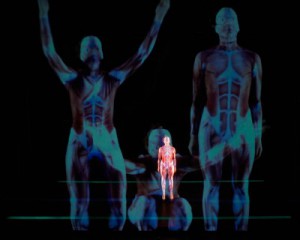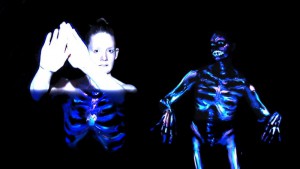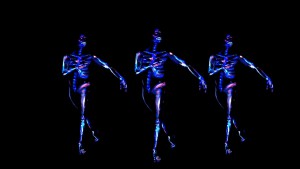Becoming Posthuman: Disappearing Bodies & Dance as Thing-Power
For the last few weeks we’ve been talking about assemblage, objects, infrastructures and articulations. But we’ve also been talking about bodies. It seems impossible to escape perceiving, feeling and thinking about the world from our subjective, human position, even when we employ object oriented ontology to level the playing field between humans and things, as we did this week. But is it possible to eschew correlationism or think a world of things outside of our human subjectivity? Our readings this week (specifically Latour and Bennett) prompt a conception of the human (body) that is no more privileged than the “things” that shape and surround it.
Some questions:
Where do the lines between human/nonhuman entities and bodies/technologies exist?
Are those lines always already blurred?
Can (nonhuman) objects have agency?
What is agency anyways?
For Bruno Latour, the agency that the “nonhuman delegate” possesses is its ability to impose behaviours “back onto the human” in a method that he (and Madeleine Akrich) call “prescription” (301). In Latour’s famous example of the mechanical door-closer, behaviours such as walking quickly when passing through the doorway and holding the door for others before it slams in their face are “prescribed” to humans by the non-human apparatus of a spring-loaded mechanism. Similarly, Latour explains, one can learn better how to drive a car by actually doing the driving than by just reading a manual. “Prescription” is an “embodied,” “intra-somatic” practice (305). Jane Bennett’s work sits somewhere on the spectrum between ecocriticism and speculative materialism, and therefore a large part of her project has to do with rethinking the body of the human subject, not as transcendent, natural or given, but as an assemblage of nonhuman materials.
Latour writes that he “sees only actors—some human, some nonhuman, some skilled, some unskilled—that exchange their properties” (303). Likewise, Bennett wishes to “flatten the ontology” between human and nonhuman entities. She prefers the term “actant” to “actor,” as “an actant can be either human or nonhuman: it is that which does something, has sufficient coherence to perform actions, produce effects and alter situations” (355).
Latour briefly touches on the computer as an actor in his paper, joking that he “talks” to his, making it (the computer) more like a human, but he fails to say how he has become more like a computer. Of course, this type of analysis (of how our technologies are making us less human and more programmed/robotic; how texting is ruining our ability to converse, etc.) is by now old news. In her influential work How We Became Posthuman, Katherine Hayles writes that our daily interactions with various screens and cybernetic systems do indeed change us: “As you gaze at the flickering signifiers scrolling down the computer screens…you have already become posthuman” (xiv). By putting Latour and Bennett in conversation with Hayles, we can think about how information age technologies produce new definitions of (human and nonhuman) agency and behavior, including a disintegration of the body as we know it.
Consider Freya Olafson’s 2013 performance artwork HYPER_:
In HYPER_, technologic objects and practices intertwine with Olafson’s corporeal feminine presence, granting her an (albeit temporary; albeit visual) “erasure of embodiment” (Hayles 4) and “independence from subjectivity” as rooted in the materiality of her body (Bennett). Bennett describes “thing-power” as “the nonhumanity that flows around but also through humans […] a protean flow of matter-energy” (349) that can be detected in actants like electricity, oil and methane (Vibrant Matter).
I would like to propose that the kinds of artistic techniques and kinetic affects produced in HYPER_ stand as a visualization of Bennet’s “thing-power,” a manifestation of the swirling movement of the materiality and information at the “heart of the condition of virtuality” (Hayles 14).
As the show begins, the lights come up on Olafson wearing a black strapless dress that fragments her body by highlighting her chest, arms and face and erasing her torso into the black scrim behind her.
Olafson assumes dancerly poses, at once both sexualized and mechanical, stopping now and again to check for her pulse. Even she, it seems, is unsure of whether she is human. Over the course of the piece, Olafson inhabits various states of “undress” by donning a bodysuit printed with human musculature and then, later, a skeleton painted directly on her skin.
HYPER_ features a mix of dance, computer animation and improvisations with technology to strip Olafson’s human body down to the “assemblage” of skeletal and muscular structures of which it is composed. If humans are, as Bennett posits, made up of a “particularly rich and complex collection of materiality,” then her further statement, that “agency is a property less of individual entities than of assemblages of humans and nonhumans,” prompts us to ask questions like where does agency really lie? (359, 360). Indeed, it is sometimes unclear who or what is controlling or motivating the dancer’s disintegration in HYPER_. Olafson’s blank eyes and listless movements suggest a lack of agency, yet these moments are interspersed with bursts of incisive kinetic energy that indicate intentional action.
In a section of her piece called “Release Technique” (7:56), Olafson projects a video of a movement study game, featuring an animated woman whose body the player manipulates through keystrokes in order to facilitate her free-fall, maneuvering her around and between large round obstacles that block her path.
The female body in this “virtual choreography” is disturbingly corpselike (her eyes are closed, her limbs are limp) and dressed in overtly-sexual attire (a black string bikini). Also unnerving is the violence the player must perform upon the female body in order to guide her path: bending her in half, hyperextending her joints and allowing her to fall directly upon her face. In fact, the virtual woman’s inhuman flexibility is the only feature that saves her body from being completely cumbersome to the game’s goal — ultimate maneuverability. That the game has no endpoint suggests an infinite infliction of brutality upon this virtual body, and the effect is both mesmerizing and revolting. What effect, I wonder, does this technological sadism have on real bodies? Is the virtual (or simulated) body more human or more nonhuman?
Towards the end of the piece (42:40), Olafson emerges from the wings having painted her limbs, torso and face with glow-in-the-dark paint to resemble a skeleton. When viewed in darkness, and with the 3D glasses provided, the rest of Olafson’s human body melts away and the audience is left with only her performative skeletal presence, which, aided by a projection, has now multiplied by three.
When she dances with her skeleton clones, they are a balletic trio that dance in perfect unison, a feat technically impossible for three real human bodies. Her counterparts are both completely her yet also separate from her, a fact that fuses the mechanical and the corporeal into a kind of emotionless ecstatic sublimity, enacting what Hayles calls our “ultimate horror” — the nightmare that the machine might absorb the human being, trapping them within “inflexible walls that rob them of their autonomy” (Hayles 105). By this point in the piece, Olafson has transformed from perceptibly human to something “other” — a cyborg presence at once both material and ephemeral, “cold” and “warm.” She dances her way through this transition, her body always in motion.
It is interesting that Olafson should use dance as her metamorphic medium. Scott R. Hutson calls the specific type of movement inspired by electronic dance music and the rave scene “dance as flow” and he notes that this type of dance “merges the act with the awareness of the act, producing self-forgetfulness, a loss of self-consciousness, transcendence of individuality and fusion with the world” (Hutson 39). The self no longer controls the body. Instead, the movement of the body becomes involuntary, controlled by music and rhythm alone, allowing the mind to abandon it. Because HYPER_ performs an illusion by which the body is dissolved into pure movement, it works as an example of the shift that Bennett also makes, from body materialism to thing-power materialism. Whereas body materialism “has tended to focus on the human body and its collective practices” as well as “the extent to which cultural notions and ideals are themselves embodied entities,” thing-power materialism “focuses on energetic forces that course through humans and cultures without being exhausted by them” (Bennett 367).
HYPER_ ends with a visual of swirling red and blue ribbons, like rogue DNA strands. The ribbons, which are guided by Olafson’s unseen hands, move in abstract and haphazard (“aleatory”) ways; they are the unpredictable flow of information, materialized. Although they are manipulated by a human’s (invisible) hands, the resulting movement of the ribbons can be seen as an artistic representation of Jane Bennett’s thing-power materialism or “vibrant matter,” possessing as they do, an “active, earthy, not-quite-human capaciousness” (3).
Tensions of autonomy and control, intimacy and impersonality plague HYPER_, which reinstates the body, and particularly the female body, as both a vehicle for and an obstacle to freedom. But what kind of “freedom” is this? What kinds of issues arise when technological escapism is posited as a means of transcendence from the body? Is the result a kind of neoliberal fantasy? Computer technologies have claimed that they can help us accomplish all that neoliberalism requires of us — precarity, availability, un-rootedness, distributed agency and skill. Is the body just a hindrance to these qualities?
Works Cited
Bennett, Jane. “The Force of Things: Steps Toward an Ecology of Matter.” Political Theory 32.3 (June 2004): 347-372.
———-. Vibrant Matter: A Political Ecology of Things. London: Duke University Press, 2010.
Hayles, Katherine. How We Became Posthuman: Virtual Bodies in Cybernetics, Literature and Informatics. London: The University of Chicago Press, 1999.
Hutson, Scott R. “The Rave: Spiritual Healing in Modern Western Subcultures.” Anthropological Quarterly 7.1 (2000): 35-49.Academic Search Premier.
Johnson, Jim [Bruno Latour]. “Mixing Humans and Nonhumans Together: The Sociology of a Door-Closer.” Social Problems 35 (1988): 298-310.
Olafson, Freya, chor. HYPER_. Freya Björg Olafson, 2013. Vimeo. 17 Apr. 2014.







Cool video, the dancing “clones” reminds me of the Norman McLaren short film “Pas de Deux” https://www.youtube.com/watch?v=WopqmACy5XI
Yes! Good eye. Love McLaren. Olafson is definitely paying homage :)
In Bennett’s article, we read: “Adorno insists, as do the ‘body materialists’ cited at the start of this essay, that things are always already humanized objects. This object status arises the very instant something comes into our awareness or under our gaze.” (p.357)
Yesterday I was reading this in the NYT: “According to quantum mechanics, particles do not take on formal properties until they are measured or observed in some way. Until then, they can exist simultaneously in two or more places. Once measured, however, they snap into a more classical reality, existing in only one place.” http://www.nytimes.com/2015/10/22/science/quantum-theory-experiment-said-to-prove-spooky-interactions.html?hp&action=click&pgtype=Homepage&module=second-column-region®ion=top-news&WT.nav=top-news&_r=0
Perhaps there is an ontological dimension to ‘vibrant matter’ in the relationship between humans and things, on a level we are just beginning to be capable of observing empirically. I don’t want to say too much about this comparison lest I step into the overtly metaphysical, but I think there is something to consider, namely that there is a sense by which the things that make up ‘reality’ are ‘real-ized’ by our gaze.
Thanks for the NYT link, Niki! Admittedly, the article is a little over my head, but I would love to talk more with you (and the class) about objects as “always already humanized,” especially in reference to your last statement, that things are only “real-ized” through our (human) gaze. I think this is the problem of correlationism that Object Oriented Ontology (and esp. Meillassoux in “After Finitude”) bumps up against. Being cannot exist without thinking; “reality” only exists as it appears to us; our minds don’t just reflect but “actively structure” reality; we can never know “things in themselves” etc.
But I wonder if Bennett’s theories of thing-power can perhaps help us think about objects as possessing a kind of agency that escapes our understanding, and therefore exists “for itself”?
I find that in the effort to rethink our privileging of the human subject, it helps to break the human itself down into parts/objects, like Malabou does with the brain (http://fordhampress.com/index.php/what-shoud-we-do-with-our-brain-cloth.html), which is what I was attempting to explore, conceptually, via Freya Olafson’s work.
The question I keep returning to is What happens to the political when we attempt to think things for themselves? Bennett’s book, “Vibrant Matter” offers some potential answers…